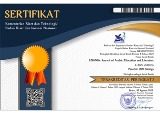Aplikasi Kamus ViKA sebagai Visualitator Kosakata Bahasa Arab untuk Pembelajar Pemula
Abstract
This research aims to produce a digital dictionary ViKA (Visualitation by Creation and Action) as media for for beginner learners to understand the meaning of Arabic vocabulary according the morphology (Creation) and syntax (Action). This Research and Development uses quantitative data for the analysis with the independent variables "ViKA Dictionary" and the dependent variable “the ineffectiveness of existing dictionaries and the effectiveness of ViKA dictionary. ViKA Dictionary is tested to 50 of 1st semester students of Arabic Education at State Institute for Islamic Studies Salatiga, with the data is obtained through Pre-ViKA and Post-ViKA questionnaires and interviews. Signification test of the data is done by two-tailed test to accept an alternative hypothesis "That students of Arabic Education 1st Semester are beginner learners and existing dictionaries give understanding of detail meaning of Arabic vocabulary yet and ViKA dictionary is effective for use", or reject the null hypothesis "That 1st semester students of Arabic Education 1st are not beginner learners and existing dictionaries give understanding of detail meaning of Arabic vocabulary and ViKA dictionary is ineffective for use ". The result of signification test according to the rules decision of two-tailed test is whether the H1 is accepted and H0 is rejected. So "ViKA Dictionary is effective being used by beginner Arabic learners".
Keywords
Full Text:
PDFReferences
Bagus Handoko. Buat Aplikasi Kamus Menggunakan Visual Basic,URL: http://coretanlusuh.blogspot.co.id/2013/03/buat-aplikasi-kamus-menggunakan-visual.html. (13 September 2016)
Daymon, Christine dan Immy Holloway. Metode-Metode Riset Kualitatif dalam Public Relations & Marketing Communications. Yogyakarta: Penerbit Bentang, 2008.
Dictionary Tutorial Part 1 - Visual Basic .NET.htm (11 September 2016)
Emzir. Metodologi Penelitian Pendidikan Kualitatif & Kuantitatif Edisi Revisi. Jakarta: PT. Raja Grafindo Persada, 2008.
Habibi, Burhan Yusuf dan Muhammad Fahrun Nadhif. Syamila. Semarang: Pustaka Amanah, 2014.
Hadi, Sutrisno. Metodologi Research. Yogyakarta: Yayasan Penerbitan Fakultas Psikologi Universitas Gadjah Mada, 1981.
Hafidz, Muhammad. Dasar-Dasar Ilmu Nahwu. Yogyakarta: Mitra Cendekia, 2009.
Kukla, Andre. Konstruktivisme Sosial Dan Filsafat Ilmu. Yogyakarta: Penerbit Jendela, 2003.
Ma’sum, Muhammad. Al-Amtsilah At-Tashrifiyah. Semarang : Wicaksono, tt.
Mahmud, Khoirotul Irawati dan Hanifuddin Magasin. Cara Belajar Cepat Abad 21 Metode Hanifida Brain Based Learning Modell Konstruktivisme cet XII. Jombang: CV. Percatakan Fajar, 2015.
Munawwir, Ahmad Warson. Al-Munawwir (Kamus Arab –Indonesia) cet XIV. Surabaya: Pustaka Progressif, 1997.
Pandia, Henry. Pemrograman dengan Visual Basic. Jakarta: Erlangga, 2006.
Sudjana. Metoda Statistika. Bandung : PT. TARSITO, 2015.
Sugiono, Metode Penelitian Kualitatif dan Kuantitatif dan Dasar-Dasar Pemrogaman Visual Studio 2010, Budi Permana. Pdf.
_______, R & D. : Bandung: Alfabeta, 2010.
DOI: https://doi.org/10.18326/lisania.v1i1.37-55
Refbacks
- There are currently no refbacks.
Copyright (c) 2017 LISANIA: Journal of Arabic Education and Literature
Statcounter View My Stats







